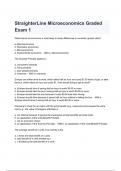-
1. Exam (elaborations) - Principles of management (straighterline.com) exam questions with complete solutions ...
-
2. Exam (elaborations) - Straighterline bio 101 final exam questions and answers 2024/2025( a+ graded 100% ver...
-
3. Exam (elaborations) - Straighterline micro exam q's questions with complete solutions 2024/2025( a+ graded ...
-
4. Exam (elaborations) - Straighterline micro chapter 14: retail pricing exam q's questions and answers 2024/...
-
5. Exam (elaborations) - Straighterline philosophy final exam questions and answers 2024/2025( a+ graded 100% ...
-
6. Exam (elaborations) - Principles of management straighterline final prep questions and answers 2024/2025( a...
-
7. Exam (elaborations) - Intro to it fundamentals - straighterline it101 course study guide exam questions and...
-
8. Exam (elaborations) - Sociology final straighterline exam questions and answers 2024/2025( a+ graded 100% v...
-
9. Exam (elaborations) - Straighterline exam 1 questions and answers 2024/2025( a+ graded 100% verified).
-
10. Exam (elaborations) - Straighterline communications final exam questions and answers 2024/2025( a+ graded 1...
-
11. Exam (elaborations) - Medical terminology (straighterline) exams 1 & 2 questions and answers 2024/2025( a+ ...
-
12. Exam (elaborations) - Straighterline intro to sociology midterm exam questions and answers 2024/2025( a+ gr...
-
13. Exam (elaborations) - Intro to sociology (straighterline) exam questions and answers 2024/2025( a+ graded 1...
-
14. Exam (elaborations) - Straighterline- exams 1,2 questions and answers 2024/2025( a+ graded 100% verified).
-
15. Exam (elaborations) - Straighterline a&p 2 exam questions and answers 2024/2025( a+ graded 100% verified).
-
16. Exam (elaborations) - Straighterline exam 1 questions and answers 2024/2025( a+ graded 100% verified).
-
17. Exam (elaborations) - Intro to biology straighterline exam questions and answers 2024/2025( a+ graded 100% ...
-
18. Exam (elaborations) - Straighterline macro quiz questions and answers 2024/2025( a+ graded 100% verified).
-
19. Exam (elaborations) - Straighterline eco 210 macroeconomics final study guide exam questions and answers 20...
-
20. Exam (elaborations) - straighterlineecon 343 exam 1 questions and answers 2024/2025( a+ graded 100% verifi...
-
21. Exam (elaborations) - Straighterline econ 104 practice quizzes questions and answers 2024/2025( a+ graded 1...
-
22. Exam (elaborations) - Straighterline organizational behavior exam questions and answers 2024/2025( a+ grade...
-
23. Exam (elaborations) - Straighterline exam 4 questions and answers 2024/2025( a+ graded 100% verified).
-
24. Exam (elaborations) - Straighterline a&p i final exam questions and answers 2024/2025( a+ graded 100% verif...
-
25. Exam (elaborations) - Straighterline macroeconomics exam questions and answers 2024/2025( a+ graded 100% ve...
-
26. Exam (elaborations) - Nutrition straighterline quizzes exam questions and answers 2024/2025( a+ graded 100%...
-
27. Exam (elaborations) - Straighterline the muscular system exam questions and answers 2024/2025( a+ graded 10...
-
28. Exam (elaborations) - Straighterline anatomy & physiology exam questions and answers 2024/2025( a+ graded 1...
-
29. Exam (elaborations) - Straighterline business stats exam questions and answers 2024/2025( a+ graded 100% ve...
-
30. Exam (elaborations) - Straighterline microbiology exam questions and answers 2024/2025( a+ graded 100% veri...
-
31. Exam (elaborations) - Phil 101 straighterline exam 3 questions and answers 2024/2025( a+ graded 100% verifi...
-
32. Exam (elaborations) - Straighterline microeconomics graded exam 1 questions and answers 2024/2025( a+ grade...
-
33. Exam (elaborations) - Straighterline us government chapter 1 exam questions and answers 2024/2025( a+ grade...
-
34. Exam (elaborations) - Straighterline communications final exam questions and answers 2024/2025( a+ graded 1...
-
35. Exam (elaborations) - Straighterline exam 1 questions and answers 2024/2025( a+ graded 100% verified).
-
36. Exam (elaborations) - Sociology exam 1 straighterline exam questions and answers 2024/2025( a+ graded 100% ...
-
37. Exam (elaborations) - Straighterline macroeconomics lesson 1 exam questions and answers 2024/2025( a+ grade...
-
38. Exam (elaborations) - Personal health and wellness- straighterline exam questions and answers 2024/2025( a+...
-
39. Exam (elaborations) - Life-span development final (straighterline) exam questions and answers 2024/2025 100...
-
40. Exam (elaborations) - Straighterline cj101 final exam questions and answers 2024/2025( a+ graded 100% verif...
-
41. Exam (elaborations) - Environmental science - straighterline exam questions and answers 2024/2025( a+ grade...
-
42. Exam (elaborations) - Straighterline business law exam questions and answers 2024/2025( a+ graded 100% veri...
-
43. Exam (elaborations) - Personal finance straighterline sections 1-7 exam questions and answers 2024/2025( a+...
-
44. Exam (elaborations) - Us history 1 straighterline final all chapters questions and answers 2024/2025( a+ gr...
-
45. Exam (elaborations) - Straighterline anatomy and physiology 1 exam questions and answers 2024/2025( a+ grad...
-
46. Exam (elaborations) - It straighterline exam questions and answers 2024/2025( a+ graded 100% verified).
-
47. Exam (elaborations) - Straighterline final exam questions and answers 2024/2025( a+ graded 100% verified).
-
48. Exam (elaborations) - Straighterline ch. 1-4 exam 1 questions and answers 2024/2025( a+ graded 100% verifie...
-
49. Exam (elaborations) - Straighterline midterm exam questions and answers 2024/2025( a+ graded 100% verified)...
-
50. Exam (elaborations) - Straighterline - a&p 1 midterm exam questions and answers 2024/2025( a+ graded 100% v...
-
51. Exam (elaborations) - Western civilization 1 straighter line final exam questions and answers 2024/2025( a+...
-
52. Exam (elaborations) - Anatomy and physiology straighter line exam questions and answers 2024/2025 already g...
-
Show more




